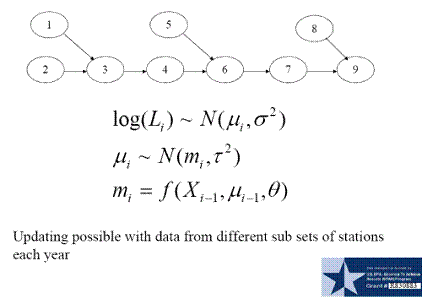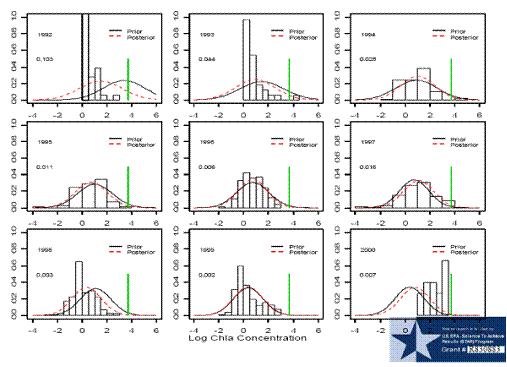Grantee Research Project Results
Final Report: Adaptive Implementation Modeling and Monitoring for TMDL Refinement
EPA Grant Number: R830883Title: Adaptive Implementation Modeling and Monitoring for TMDL Refinement
Investigators: Reckhow, Kenneth H. , Stow, Craig A. , Shabman, Leonard A. , Borsuk, Mark E. , Roessler, Chris , McMahon, Gerard
Institution: Duke University , United States Geological Survey , Resources for the Future
Current Institution: Duke University , Resources for the Future , United States Geological Survey
EPA Project Officer: Packard, Benjamin H
Project Period: June 1, 2003 through May 31, 2006 (Extended to October 30, 2007)
Project Amount: $660,171
RFA: Developing Regional-Scale Stressor-Response Models for Use in Environmental Decision-making (2002) RFA Text | Recipients Lists
Research Category: Aquatic Ecosystems , Ecological Indicators/Assessment/Restoration
Objective:
The overall objective of this research project is to develop an adaptive implementation modeling and monitoring strategy (AIMMS) for total maximum daily load (TMDL) improvement. Another objective of this project is to apply and evaluate AIMMS on the Neuse Estuary TMDL in North Carolina.
Ecological Significance
- The Neuse River drains into Pamlico Sound, which is one of the most important fish nursery areas in the mid-Atlantic.
- The Neuse Estuary supports recreational and commercial fishing and shellfishing.
Effects of Multiple Stressors
- Nitrogen is the nutrient that generally controls algal density, although the relationship is relatively weak.
- River flow and salinity are also factors important in algal density.
- Wind and stratification affect oxygen level, which in turn influences fish and shellfish.
Summary/Accomplishments (Outputs/Outcomes):
Lessons Learned
- It is feasible to develop and update a Bayesian model for pollutant loading and water body response, that can be regularly updated with new monitoring data.
- The Neuse Estuary achieved compliance with the chlorophyll criterion far sooner than expected, due to an aggressive nitrogen control program in North Carolina.
Interactions with Potential Users
- North Carolina Division of Water Quality – evaluation of chlorophyll criterion compliance
- EPA Council for Regulatory Environmental Modeling – to develop a proposal to build upon this STAR project
- EPA OW, WERF, AMSA (and other groups) – additional support for the Adaptive Implementation White Paper
Other Project Outcomes & Benefits
- Developing a joint research proposal with the EPA Council for Regulatory Environmental Modeling to continue model development with Bayesian updating using remote sensing data
- Funded three students at Duke
Previously…
- Models are likely inadequate
- Adaptive Implementation (AI): learning while doing
- Key to AI: monitoring and post-implementation assessment
- Bayesian statistics as an analytical tool
- Examples: TN, chla, and chlamodel parameter updating results

Post (TMDL) Implementation Questions
Year 3 Issues
- Use the CUAHSI “digital watershed”to efficiently link SPARROW and NeuBERN
- Represent land use (pollutant load) change in SPARROW
- Characterize prior probabilities for SPARROW parameters
- Design monitoring program (sensitivity analysis)
Coupling the HIS with the Neuse Bayesian Nitrogen Model
- A automated data retrieval system
- A reach based nitrogen loading model
Reach-Based State-Space Model
- Model framework:
- Stream reach as the basic building block
- Separating model and observation errors
- Sequential updating model coefficient distributions
- Model features:
- Using all available information
- Accounting for spatiotemporal correlation
- Ease of implementation
Model Description
- Example watershed with 9 stream reaches
- Used previously to illustrate SPARROW with 3 sub-watersheds

Expected Outcomes
- A coupled HIS-SPARROW (reach-based) watershed nitrogen loading model for the Neuse
- An automated modeling framework for:
- Re-assessment of the Neuse nitrogen TMDL for NC Division of Water Quality
- Development of guidelines and procedures for adaptive implementation of TMDLs
Journal Articles:
No journal articles submitted with this report: View all 9 publications for this projectSupplemental Keywords:
RFA, Ecosystem Protection/Environmental Exposure & Risk, Scientific Discipline, Water, Economic, Social, & Behavioral Science Research Program, Economics & Decision Making, Watersheds, decision-making, Regional/Scaling, Monitoring/Modeling, Water & Watershed, Ecology and Ecosystems, Environmental Monitoring, ecological variation, ecology, ecosystem assessment, adaptive implementation modeling, water quality, Bayesian approach, watershed assessment, risk assessment, ecological models, aquatic ecosystem, environmental decision making, TMDL, water monitoring, Bayesian classifiers, ecosystem stress, assessment endpoint mechanistic research, decision analysis, ecological indicators, ecology assessment models, decision support tool, decision making, environmental risk assessment, watershed, regional scale impactsProgress and Final Reports:
Original AbstractThe perspectives, information and conclusions conveyed in research project abstracts, progress reports, final reports, journal abstracts and journal publications convey the viewpoints of the principal investigator and may not represent the views and policies of ORD and EPA. Conclusions drawn by the principal investigators have not been reviewed by the Agency.








